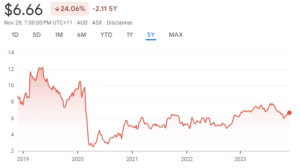Why Is Webjet’s Stock still lagging over 45% below its pre-COVID peak? Look above the Clouds!
![]() Ujjwal Maheshwari, December 1, 2023
Ujjwal Maheshwari, December 1, 2023
Webjet (ASX: WEB), a prominent player in the online travel agency sector, has seen its stock plummet by 10.3% over the past three months. This downward spiral raises questions – is the market neglecting its fundamentals and the travel book? In a scenario where long-term fundamentals typically steer market trajectories, a closer examination of the company’s financial health seems imperative.
This article aims to dissect the factors behind Webjet’s declining stock value and its implications for the future. To make a long story short: even though there is a travel boom, Webjet is necessarily thriving in an industry that is far more competitive and lower-margin than pre-pandemic.

Webjet’s ROE Concern
Central to understanding this company’s financial performance is its Return on Equity (ROE). Yes, many investors like to focus on profit, although this is not as important for a company like Webjet with its commission-based revenue model. This is not because Webjet isn’t currently profitable, making $69.9m in FY23 (the 12 months to March 31 2023) and $47.3m for the first half of FY24 (1HY24).
Instead, it is because we think ROE serves as a crucial indicator of how effectively a company is growing its value and managing its cash. For Webjet, the calculation reveals an ROE of 1.7% based on the trailing twelve months to March 2023, a figure that suggests for every A$1 of shareholder capital, the company generated a mere A$0.02 in profit. When juxtaposed with the industry average ROE of 6.5%, Webjet’s number appears alarmingly low, potentially contributing to the stock’s downward trend.
The company’s meagre ROE reflects poorly on its earnings growth prospects. Historically, companies with high ROE and profit retention rates exhibit robust growth trajectories. This is not so with this company, its earnings have experienced a significant five-year decline, a trend that may be attributed to its lower-than-industry-average ROE. This declining earnings growth raises red flags about the company’s future profitability and stock performance.
What are the Best ASX Stocks to invest in right now?
Check our buy/sell tips
Analysts’ Hope and Recovering Strategies
Despite the downtrend, some analysts remain cautiously optimistic about Webjet’s growth prospects. They argue that the travel industry still has some growth left in it and that could benefit Webjet given its established market presence and online business model. It is a far more established player than Helloworld or Serko. And Webjet has diverse service offerings, including the WebBeds B2B platform and the GoSee car rental service. They assess how these segments could contribute to the company’s overall financial recovery and growth, especially considering the gradual revival of global travel.
However, there are a few harsh realities. First of all, the travel agent industry is ultra-competitive – a fact that was true even pre-pandemic. Second, travel agencies are a far lower-margin business than pre-pandemic given many airlines have slashed commissions payable to travel agencies. Thirdly, it is still uncertain if travel demand will hold up amidst fears of a global recession. No one is suggesting demand will go back to the dark days of 2020, but could middle-class travellers (which form the bulk of Webjet’s clientele base, at least in-store) cut back on their spending on travel? Might they put off holidays, or perhaps go somewhere cheaper next year?
Lagging in some respects
In comparing Webjet’s performance with its industry, the company’s plight becomes more evident. Some metrics are ahead of pre-pandemic levels. Bookings by raw number are 50% ahead and revenues are 26% ahead. However, its expenses are up 31% from pre-pandemic and the average booking value is 9% lower than pre-pandemic. The company has had to hire more staff to cope with the demand and it is getting less commissions since providers like airlines slashed their rates. And we’re not talking about a 10% cut, we’re talking cuts of up to 80% (Qantas slashed it from 5% to 1% just to name one airline). Finally, we observe that travel demand is at 97.3% of pre-pandemic levels according to the IATA. This begs the question that if Webjet’s share price couldn’t return to pre-pandemic levels during the bulk of the recovery, how will it substantially improve during what is the end of the recovery?
Until there is more certainty as to the question as to if Webjet really will be able to capture a share of the travel recovery, it is difficult to see the company returning to its pre-pandemic levels (which was over $12 per share in mid-2019). There are opportunities in the travel space, but they do not lie in travel agencies like Webjet.
Blog Categories
Get Our Top 5 ASX Stocks for FY26
Recent Posts
REA Group (ASX:REA): Here’s why succeeded over Domain Group at home, but hasn’t done that well abroad
REA Group (ASX:REA) is best known in Australia as the owner of realestate.com.au. For so long, the company (which is…
Here’s why companies undertake demergers and spinoffs, and some of the most famous deals in the last decade!
Investors often get themselves into frenzies over M&A deals (or just speculation of them), but demergers and spinoffs get less…
Catapult Sports (ASX:CAT) Plunges on Tech Rout: Should You Buy This Dip or Wait?
Catapult Sports (ASX: CAT) fell 8% yesterday as a broader tech selloff swept the ASX, dragging the sector down 6%.…



